
Succulents by
Little Dog Flower Farm
-
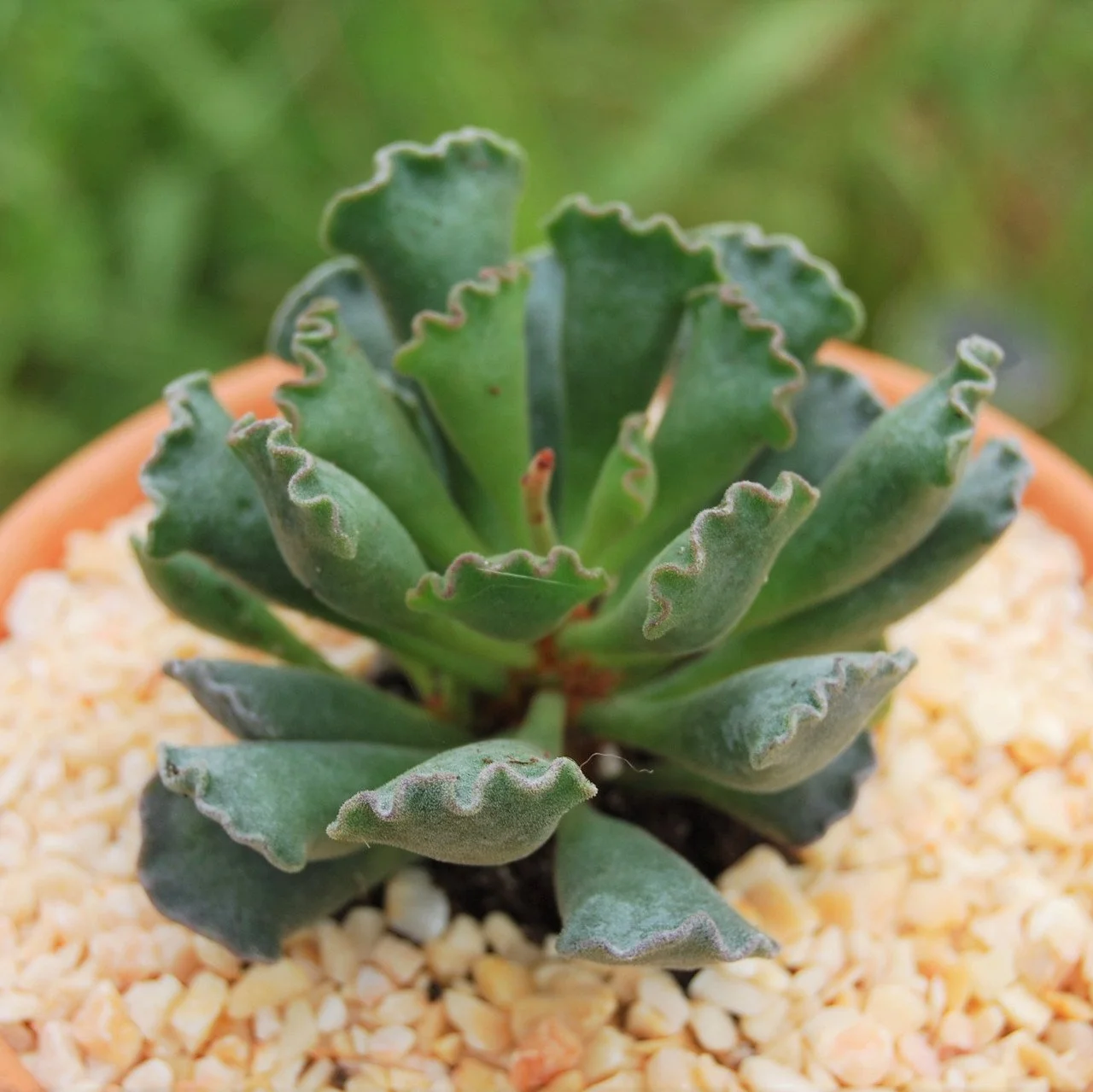
Adromischus cristatus 'Crinkle Leaf Plant'
This unique loose rosette has plump, wedge-shaped leaves with rippled edges. A short covering of short hairs on the leaves gives a silvery look to blue/green leaves. It can sprout copper aerial roots along its stem.
Size: 3”-5" height x 5”-6" w
Growth Habit: Loose Rosette
Soil: Well-draining succulent soil with 50% to 70% mineral grit such as coarse sand, pumice, or perlite.
Light: Bright Indoor Light, Filtered / Partial Sun
Water: Water deeply enough for water to run out of the drainage hole, then wait for the soil to fully dry before watering again.
Hardiness: Zone 10 (30F)
Protect from frost
-
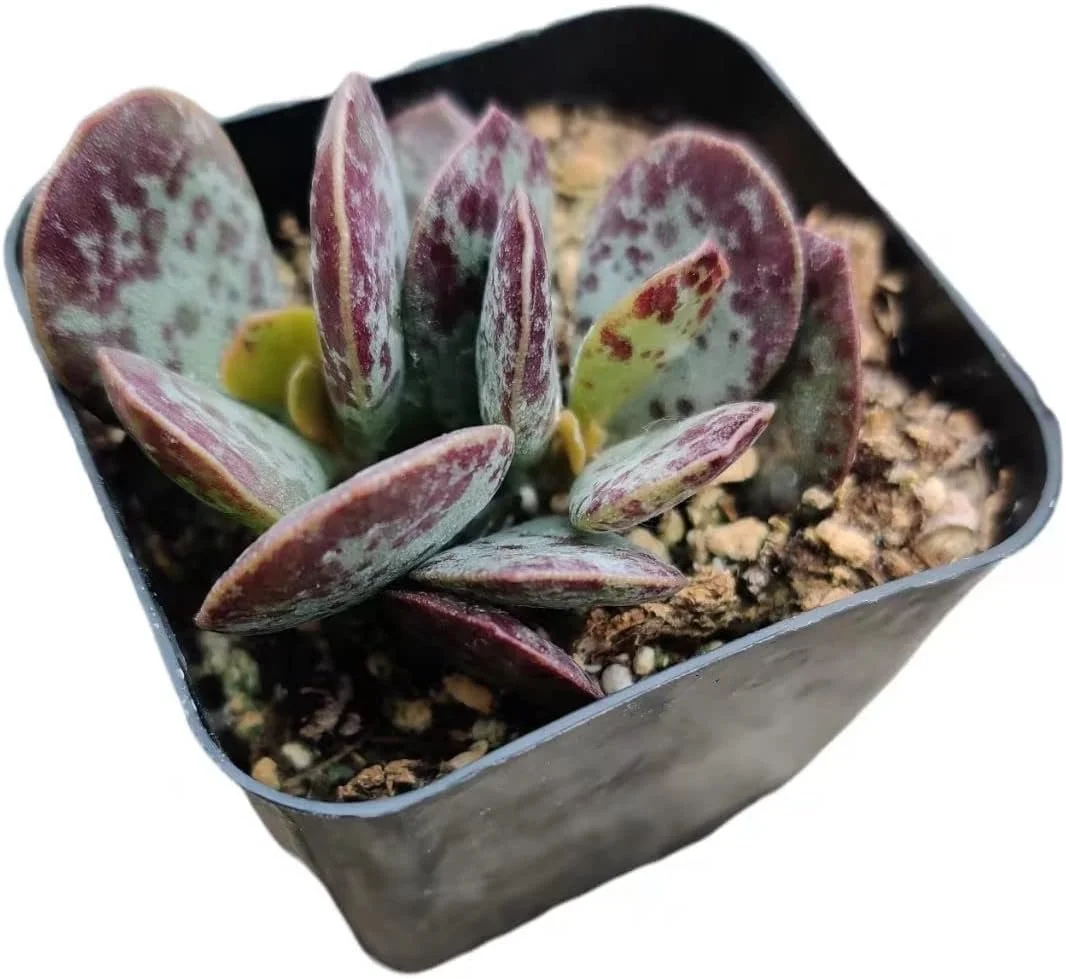
Adromischus maculatus
Flat grey/green leaves heavily speckled with reddish/purple. This stemmed succulent has fairly large leaves and grows nicely on a windowsill. Exposure to bright sunlight will bring out the best red tones.
Size: 6"-8"
Growth Habit: Vertical Grower / Tall Stem
Soil: Use well-draining cactus succulent soil with 50% - 70% mineral grit such as coarse sand, pumice, or perlite.
Light: Bright, indirect sunlight
Water: Water deeply enough for water to run out of the drainage hole, then wait for the soil to fully dry before watering again.
Hardiness: USDA Zone 10a (30-35° F)
Protect from frost
-
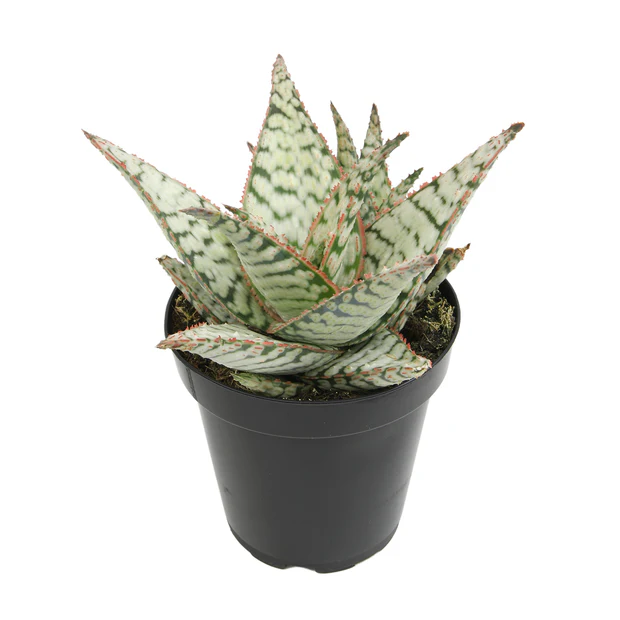
Aloe 'Candy Cane'
Rosette of white, green, and serrated blush red edges. Aloe 'Candy Cane' is most apt to bloom when the weather is warm and the plant gets adequate water. Bright light brings out a deeper white color and bolder red edges.
Size: 6"-8" high and wide
Growth Habit: Loose Rosette
Soil: Use well-draining succulent soil with 50% to 70% mineral grit such as coarse sand, pumice, or perlite.
Light: Bright, indirect sunlight for at least 6 hours a day to maintain its vibrant hues and promote healthy growth.
Water: Water deeply enough for water to run out of the drainage hole, then wait for the soil to fully dry before watering again.
Hardiness: USDA Zone 10 (30F)
-
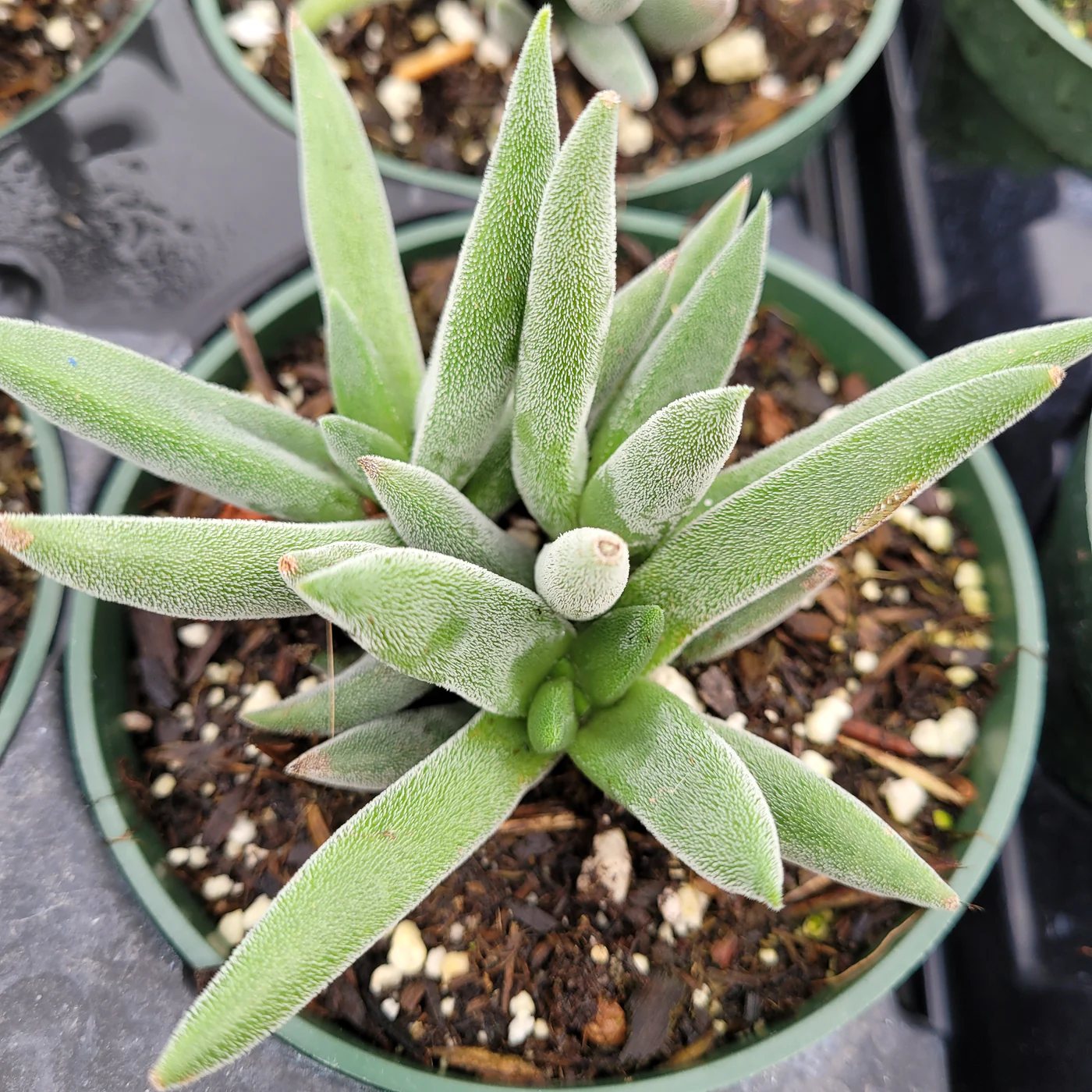
Crassula mesembryanthemoides 'Tenelli'
Crassula mesembryanthemoides 'Tenelli' has long, slim leaves covered in silvery fuzz, giving a frosted look to the plant. This stemmed plant adds height dish containers.
Size: 6"-8"
Growth Habit: Vertical Grower / Tall Stem
Soil: Use well-draining succulent soil with 50% to 70% mineral grit such as coarse sand, pumice, or perlite.
Light: Bright Indoor Light, Filtered / Partial Sun
Water: Water deeply enough for water to run out of the drainage hole, then wait for the soil to fully dry before watering again.
Hardiness: Zone 10 (30F)
Protect from frost
-

Crassula ovata 'ET's Fingers' Jade
'ET's Fingers' is a monstrose variety of the beloved Jade Plant with tubular, variable leaves and round, suction cup-like tips that turn red in direct sun. Like the classic Jade Plant, this is a low-maintenance indoor plant, Crassula can show tiny white or black dots on their leaves. These are healthy, water-transferring pores called “hyathodes” and not a sign of disease.
Size: Over 12"
Growth Habit: Shrub, Vertical Grower / Tall Stem
Soil: Gritty, well-draining soil.
Light: Filtered / Partial Sun, Low Indoor Light
Water: Water deeply when the soil is completely dry.
Hardiness: Zone 10 (30F)
Protect from frost
-
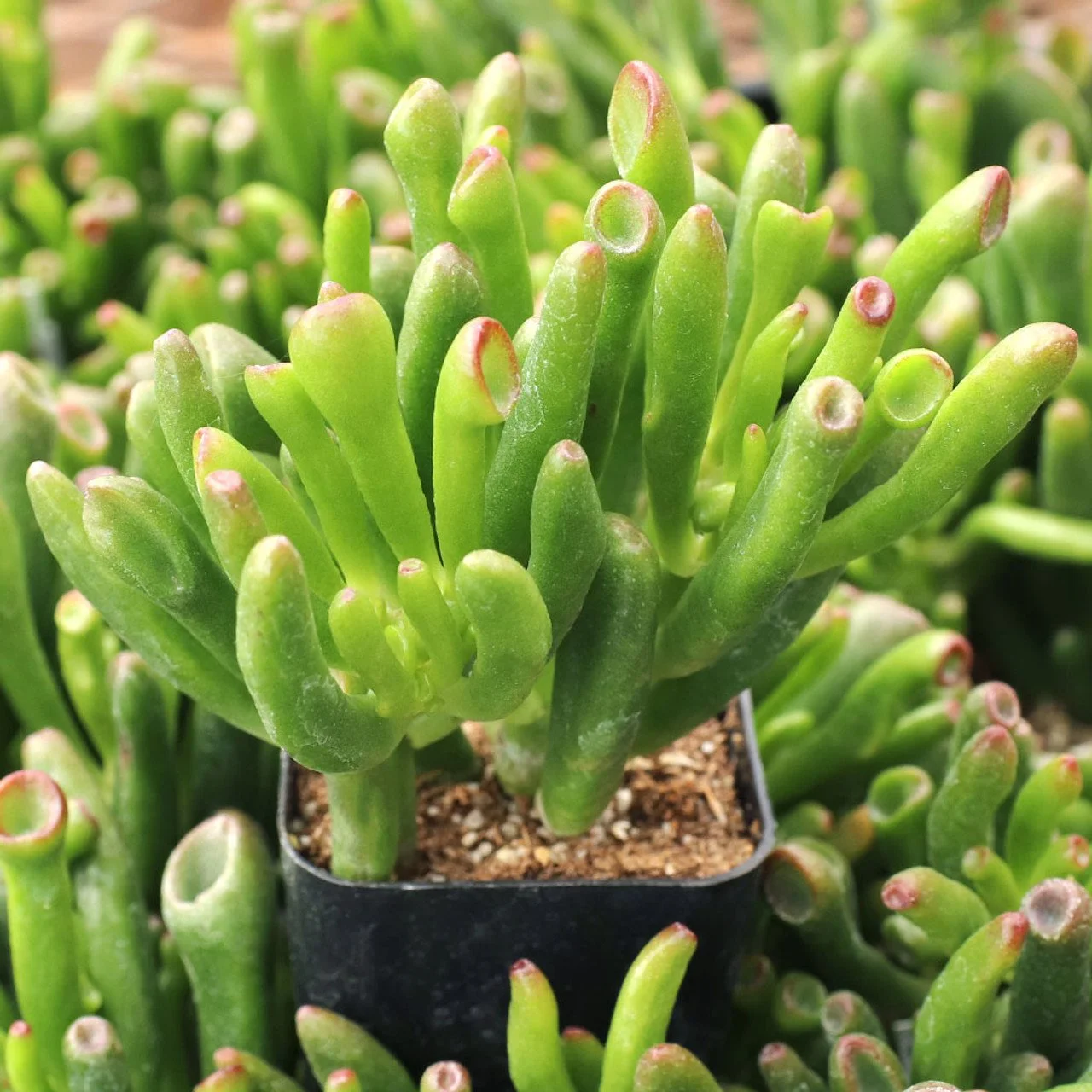
Crassula ovata 'Gollum' Jade
'Gollum' is another monstrose variety of the much-loved Jade Plant. The leaves curl in upon themselves and have round, suction cup-like tips that turn red in direct sun.
Crassula can show tiny white or black dots on their leaves. These are healthy, water-transferring pores called "hydathodes" and not a sign of disease.
Size: Over 12"
Growth Habit: Vertical Grower / Tall Stem
Soil: Gritty, well-draining soil.
Light: Filtered / Partial Sun, Low Indoor Light
Water: Water deeply when the soil is completely dry.
Hardiness: Zone 10 (30F)
Protect from frost
-

Crassula ovata 'Jade Plant'
The classic! Jade (Crassula ovata) is an easy-to-grow succulent that may be the gateway succulent! Its shiny leaves sprout from thick branches and can flush red at the edges when exposed to direct sun. Crassula can show tiny white or black dots on their leaves. These are healthy, water-transferring pores called "hydathodes" and not a sign of disease.
Size: Over 12"
Growth Habit: Vertical Grower / Tall Stem
Soil: Gritty, well-draining soil
Light: Bright Light, Filtered/Partial Sun
Water: Water deeply when the soil is completely dry.
Hardiness: USDA Zone 10a (30-35° F)
Protect from frost
-
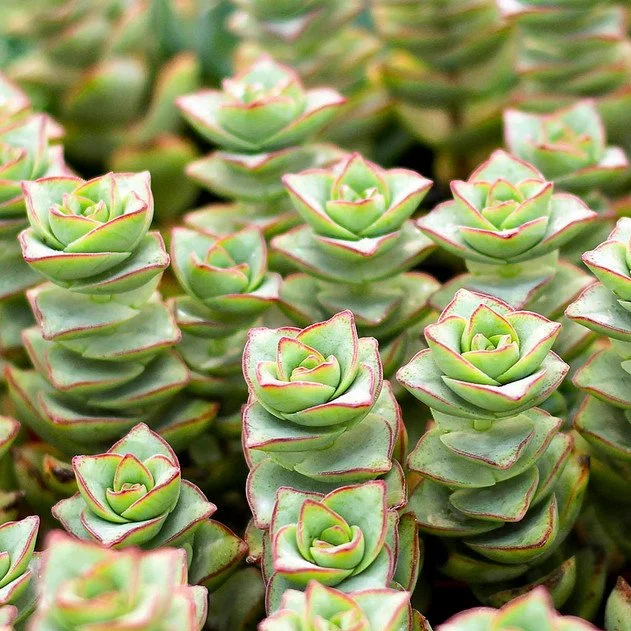
Crassula x perforata Ivory Towers
'Ivory Towers' is a tall-growing succulent with stacks of thick, joined leaf pairs around its stem. If given plenty of sunshine its green leaves will take on a dark pink outline. This succulent can be planted in a hanging pot for a beautiful cascade.
Size: Over 12"
Growth Habit: Hanging/Trailing, Vertical Grower/Tall Stem
Soil: Use well-draining succulent soil with 50% to 70% mineral grit (coarse sand, pumice, or perlite.)
Light: Bright Indoor Light, Filtered / Partial Sun
Water: Water deeply enough for water to run out the drainage hole, then wait for the soil to fully dry before watering again.
Hardiness: Zone 10 (30F)
Protect from frost
-
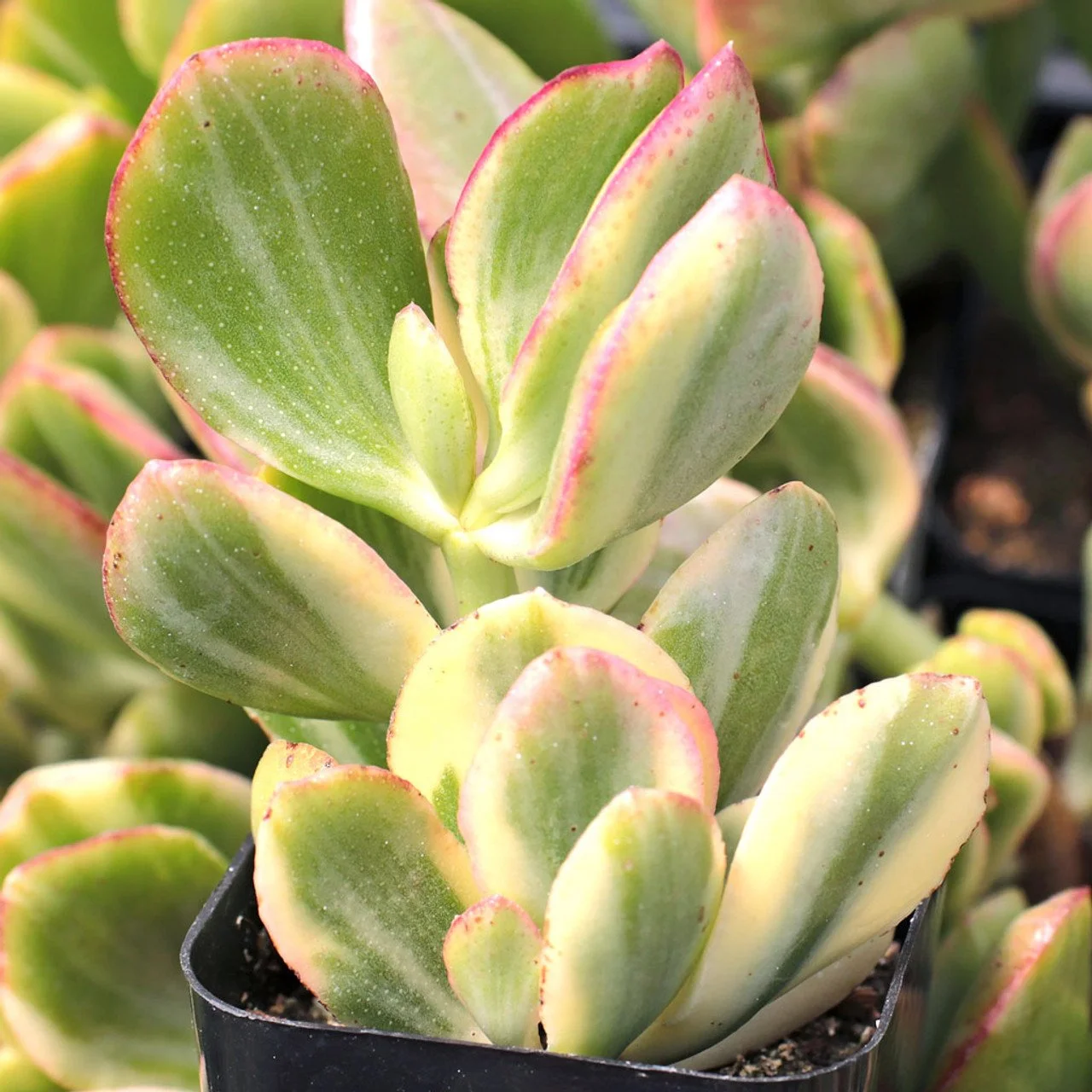
Crassula ovata 'Tricolor' - Jade Plant
An easy-to-grow succulent, 'Tricolor' Jade Plant's leaves are variegated with green and white streaks, with a pink margin if givenbright sun. Perfect for your window sill or other bright spot in your home! Jade is a forgiving grower and makes a great choice for beginners. Crassula can show tiny white or black dots on their leaves. These are healthy, water-transferring pores called "hydathodes" and not a sign of disease.
Size: Over 12"
Growth Habit: Vertical Grower / Tall Stem
Soil: Porous soil with adequate drainage
Light: Bright, indirect sunlight, Filtered / Partial Sun
Water: Water deeply, but only when the soil is completely dry.
Hardiness: Zone 9 (20F), Zone 10 (30F)
Protect from frost
-

Crassula undulatifolia 'Ripple Jade'
A wonderful variety of jade, 'Ripple Jade' is a hardy, low-maintenance plant. Its blue-green leaves have a wavy appearance and bright sun will encourage reddish edges to leaves.
Size: Over 12"
Growth Habit: Shrub, Vertical Grower / Tall Stem
Soil: Use well-draining succulent soil
Light: Bright Light, Filtered / Partial Sun
Water: Water deeply when the soil is completely dry
Hardiness: USDA Zone 10 (30F)
Protect from frost!
-

Echeveria minima
This minima (mini) hybrid forms tiny rosettes of frosted blue/sage leaves with blush at tips and edges. Clusters of small bell-shaped orange flowers appear in late spring. Wonderful in a windowsill or dish gardens.
Size: 3" high and 3-4" wide
Growth Habit: Rosette
Soil: Use well-draining succulent soil with 50% to 70% mineral grit such as coarse sand, pumice, or perlite.
Light: Bright Indoor Light (or may become leggy)
Water: Water deeply enough for water to run out of the drainage hole, then wait for the soil to fully dry before watering again.
Hardiness: USDA Zone 10 (30F)
Protect from frost
-
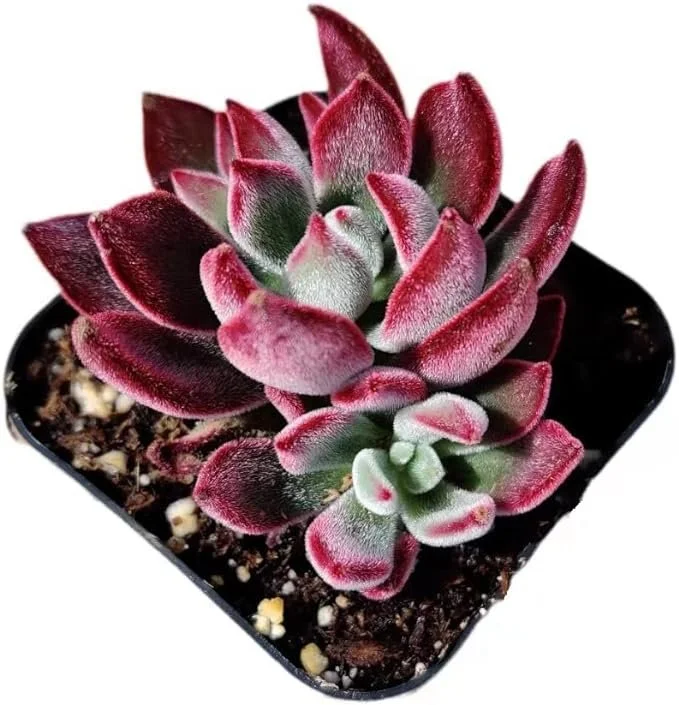
Echeveria pulvinata 'Devotion'
This beautiful non-flowering succulent has short stems and a dense terminal rosette of lush green. Burgundy leaves are covered with delicate velvety hairs. It maintains an rounded shape and stays compact. 'Devotion' take on a deeper red hue when exposed to stronger light.
Size: Up to 6" in height, 5"-6" rosettes
Growth Habit: Vertical Grower / Tall Stem
Soil: Porous soil with adequate drainage
Light: Bright Indoor Light, Full Sun.
Water: Water deeply enough for water to run out the drainage hole, then wait for the soil to fully dry before watering again.
Hardiness: USDA Zone 10a (30-35° F)
Protect from frost
-
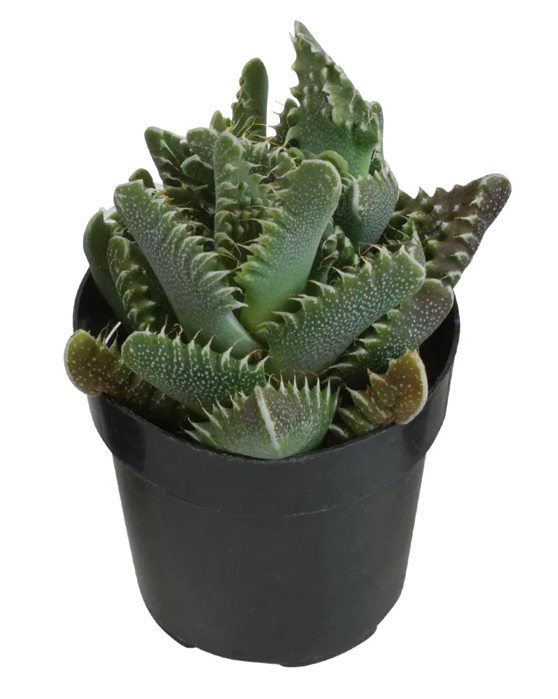
Faucaria tigrina "Tiger Jaws"
Part of the mimicry group of succulents, Faucaria tigrina ‘Tiger Jaws’ has rosettes of thick, fleshy triangular grayish-green leaves. The gentle "teeth" lining the leaf pairs can have fine tendrils at their points. This variety is a compact, clumping species.
Size: 3-5"
Growth Habit: Clumping / Mounding, Loose Rosette
Soil: Use well-draining succulent soil with 50% to 70% mineral grit such as coarse sand, pumice, or perlite.
Light: Bright Indoor Light, Filtered / Partial Sun
Water: Water thoroughly when soil is completely dry to the touch
Hardiness: Zone 10 (30F)
Protect from frost
-

Gasteria ‘Little Warty’
This adorable plant is wonderful for beginners! Gasteria is a slow growing, summer-dormant succulent with small bumps that run across thick light and dark green leaves, giving it a very interesting texture. Plant 'Little Warty' in deep pots with drainage holes as it grows deep roots and will not tolerate standing water.
Size: 3"-5"
Growth Habit: Clumping / Mounding
Soil: Gritty, well-draining soil
Light: Low Indoor Light
Water: Water deeply, but only when the soil is fully dry
Hardiness: USDA Zone 10 (30-35° F)
Protect from frost
-
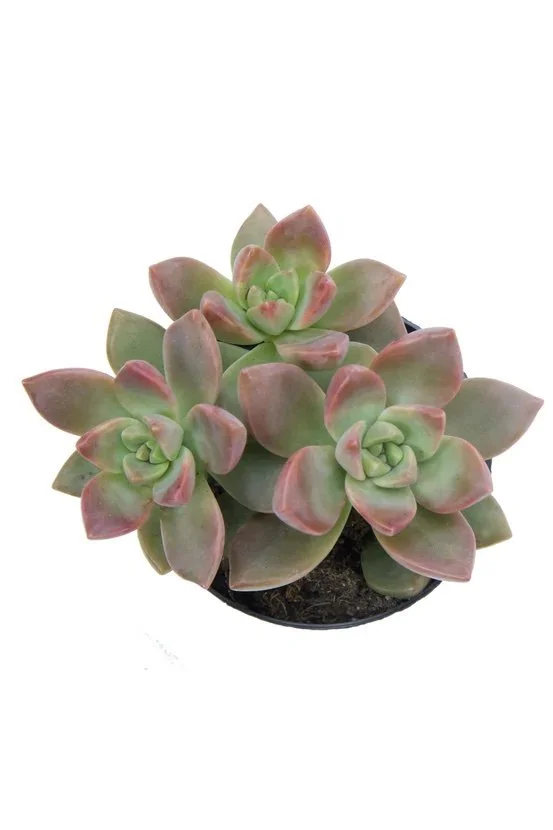
Graptosedum ‘California Sunset’
Graptosedum ‘California Sunset’ forms rosettes with lance-shped blue/green leaves that blush pinkish-orange in strong light. Excellent color accent for rock gardens!
Size: 6"-8"
Growth Habit: Vertical Grower / Tall Stem
Soil: Use well-draining succulent soil with 50% to 70% mineral grit such as coarse sand, pumice, or perlite.
Light: Provide bright light with ample airflow
Water: Water deeply enough for water to run out the drainage hole, then wait for the soil to fully dry before watering again.
Hardiness: USDA Zone 10a (30-35° F)
Protect from frost
-

Haworthia fasciata 'Zebra Plant'
Haworthia can tolerate low, indoor light, making them excellent houseplants, even for beginners! Upright rosettes with tapering dark-green leaves covered with silvery white bumps that connect to form zebra stripes. Haworthias are winter growers and are dormant in the hottest summer months, it is important not to overwater or fertilize during summer dormancy and water a bit more frequently in the winter growing season.
Size: 3" in height, 5"-6" rosettes
Growth Habit: Loose Rosette
Soil: Porous soil with adequate drainage
Light: Low Indoor Light, Filtered/Partial Sun
Water: Water thoroughly when soil is completely dry to the touch
Hardiness: USDA Zone 10a (30-35° F)
Protect from frost
-

Kalanchoe tomentosa
"Tomentose" describes the soft, fuzzy layer of hairs enveloping the entire plant, aiding its resilience in arid, sun-exposed environments. Its elongated leaves stand erect, displaying a silvery green hue adorned with chocolate brown spots along their edges. There are many varieties: Panda, Hairy Harry, and more!
Size: Over 12" high
Growth Habit: Vertical Grower / Tall Stem
Soil: Use well-draining succulent soil with 50% to 70% mineral grit such as coarse sand, pumice, or perlite.
Light: Bright indirect light
Water: Water deeply enough for water to run out the drainage hole, then wait for the soil to fully dry before watering again.
Hardiness: Zone 10 (30F)
-
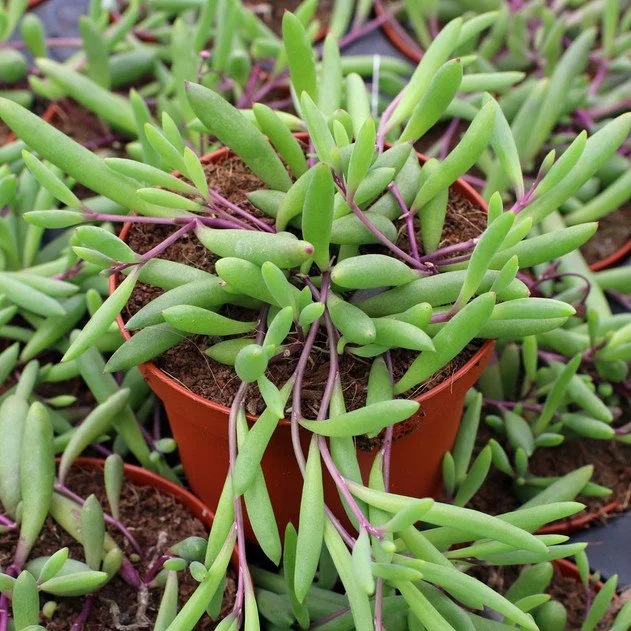
Othonna capensis 'Ruby Necklace'
'Ruby Necklace' (Othonna capensis): A beautiful trailing variety with little bean-shaped leaves that hang on stems up to 2.0' long. The whole plant can flush a striking shade of magenta when moderately stressed by direct sun, drought, or cool temperatures (around 50F). It grows fine, white tufts of fuzz in the crevices between stems and leaves.
Size: Over 12"
Soil: Porous soil with adequate drainage
Light: Bright indirect light
Water: thoroughly when soil is completely dry to the touch
Hardiness: USDA Zone 10
-

Pleiospilos nelii 'Split Rock'
Belonging to the "mimicry" family of succulents, Pleiospilos nelii "Split Rock" has grayish-green leaves that create a split "egg-shaped" appearance referred to as a bi-lobe. These leaves are speckled with numerous tiny dots which are stomates (a pore that regulates the rate of gas exchange between the internal air spaces of the leaf and the atmosphere).
Split rocks will not endure low-light or over-watering. Only use quick-draining soil and a tall, narrow pot with adequate drainage.ith a drainage hole.
New growth appears as new leaf pairs in the split’s center. It is normal for the outer leaf pair to dry and shed as its stored water is used for the new growth. Wrinkled outer leaves are not necessarily a sign that the plant needs water. Use the firmness of the inner leaf pair to determine if your plant needs water.
Split rocks are slow growers, so you should only repot them every 3–5 years. When you do repot, choose a pot that's about 4 inches deep with a hole at the bottom to provide proper drainage and enough room for the roots to grow.
Size: 3"-5" height, 3" - 4" rosette
Growth Habit: Rosette
Soil: Use soil that does not contain much organic material, such as peat moss and that the plant is not fertilized with heavy nitrogen as this can cause soft, flabby growth that lead to bacterial rots.
Light: Bright light with ample airflow
Water: Water plant deeply in spring and fall, but only if the soil is dry and the inner leaf pair starts to feel soft. These plants are very susceptible to rot and should be left fairly dry in the summer and winter.
Hardiness: USDA Zone 10
Protect from frost
-

Portulacaria afra 'Elephant Bush'
This stemmed succulent is easy to grow. It has unusual reddish-brown stems contrasting beautifully with the glossy, rounded, variegated or solid green leaves. In its native home (South Africa and Swaziland), it has a symbiotic relationship with elephants: elephants eat some of the branches, and their trampling aids the propagation of new shrubs from stem cuttings.
Size: Indoors, up to 12"
Growth Habit: Shrub, Vertical Grower / Tall Stem
Soil: Porous soil with adequate drainage
Light: Full Sun, Bright Indoor Light
Water: Water deeply but very infrequently, particular during winter dormancy.
Hardiness: USDA Zone 10a (30-35° F)
Protect from frost
-
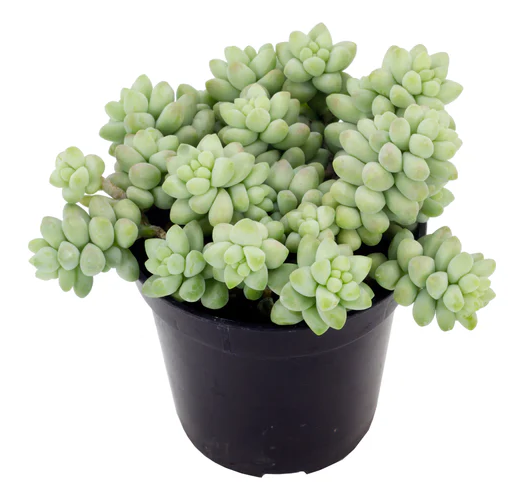
Sedum 'Burrito'
A beloved succulent, Burrito has trailing stems reaching up to 3.0' in length adorned with bead-like, green leaves. Ideal for hanging containers with proper drainage and gritty soil, it craves ample sunlight. Though its leaves may drop off with ease, both leaves and stem segments readily propagate when replanted, effortlessly regenerating roots.
Size: Can trail to 3'
Growth Habit: Hanging / Trailing
Soil: Porous soil with good drainage
Light: Bright Indoor Light, Filtered / Partial Sun
Water: Water deeply when the soil is dry.
Hardiness: Zone 10 (30F)
Protect from frost
-

Sempervivum arachnoideum - Hardy Hens and Chicks ‘Coral Red’
Hardy Hens and Chicks ‘Coral Red’ shows off its vibrant red color throughout most the year when grown in full sun. Grow in full to partial sun in a rock garden, patio container or even an indoor windowsill. It can turn green when grown in low light. Has a very strong root system and branches well.
Size: 4" in height
Growth Habit: Rosette
Soil: Porous soil with adequate drainage
Light: Full Sun, Partial Sun.
Water: Weekly watering, protect from heavy rains and standing water to prevent rot.
Hardiness: USDA Zones 4-9
-
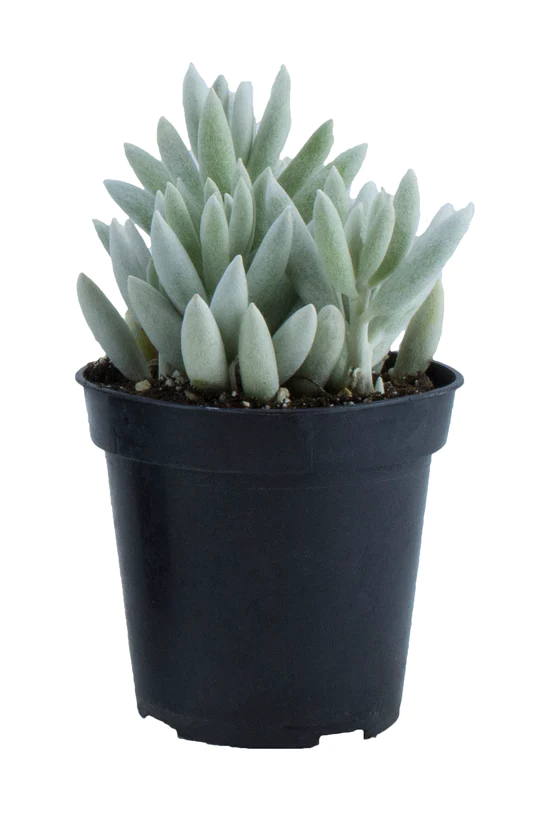
Senecio haworthii
Senecio haworthii is a unique plant with elongated grey/green leaves covered in a white, velvety coating. The plant can grow tall, leggy stems, but can be trimmed back and cuttings re-rooted. The plant stem can darken as it grows. A great plant to add textural and color interest to mixed succulent pots.
Size: Up to 6 inches high | 1-2 feet wide
Growth Habit: Vertical Grower / Tall Stem
Soil: Use well-draining succulent soil with 50% to 70% mineral grit such as coarse sand, pumice, or perlite.
Light: Bright light and ample airflow
Water: Water deeply enough for water to run out the drainage hole, then wait for the soil to fully dry before watering again.
Hardiness: Zone 10 (30F)
-

Senecio jacobsenii 'Trailing Jade'
While it looks similar to Crassula jade, Trailing Jade is not closely related to Crassula jade at all. Trailing jades look particularly striking in hanging baskets that allow the stems to hang down. Leaves can grow up to 3 inches. With limited root structure and slow growth, Trailing Jade plants don’t require repotting often. Bright sun can induce vibrant flushing from lilac to magenta.
Size: Over 12"
Growth Habit: Hanging / Trailing, Low Growing / Creeping
Soil: Porous, sandy soil with good drainage
Light: Bright light, partial Sun
Water: Water when soil is completely dry
Hardiness: USDA Zone 10a (30-35° F)
Protect from frost
-

Senecio rowleyanus "String of Pearls"
In the wild, it grows as ground cover in the shade of rocky outcroppings, but in our neck of the woods, SoP is a favorite for its cascading effect! Slender, trailing stems with "pearl" shaped leaves provide a "spiller" interest in succulent arrangements. For a full, mature look, prune long strands and place back in the pot to re-root. Summer Dormant Partial
Size: Over 12"
Growth Habit: Hanging / Trailing
Soil: Use well-draining succulent soil with 50% to 70% mineral grit such as coarse sand, pumice, or perlite.
Light: Bright, indirect sun is ideal
Water: Water deeply enough for water to run out the drainage hole, then wait for the soil to dry before watering again.
Hardiness: Zone 10 (30F)
Protect from frost
-
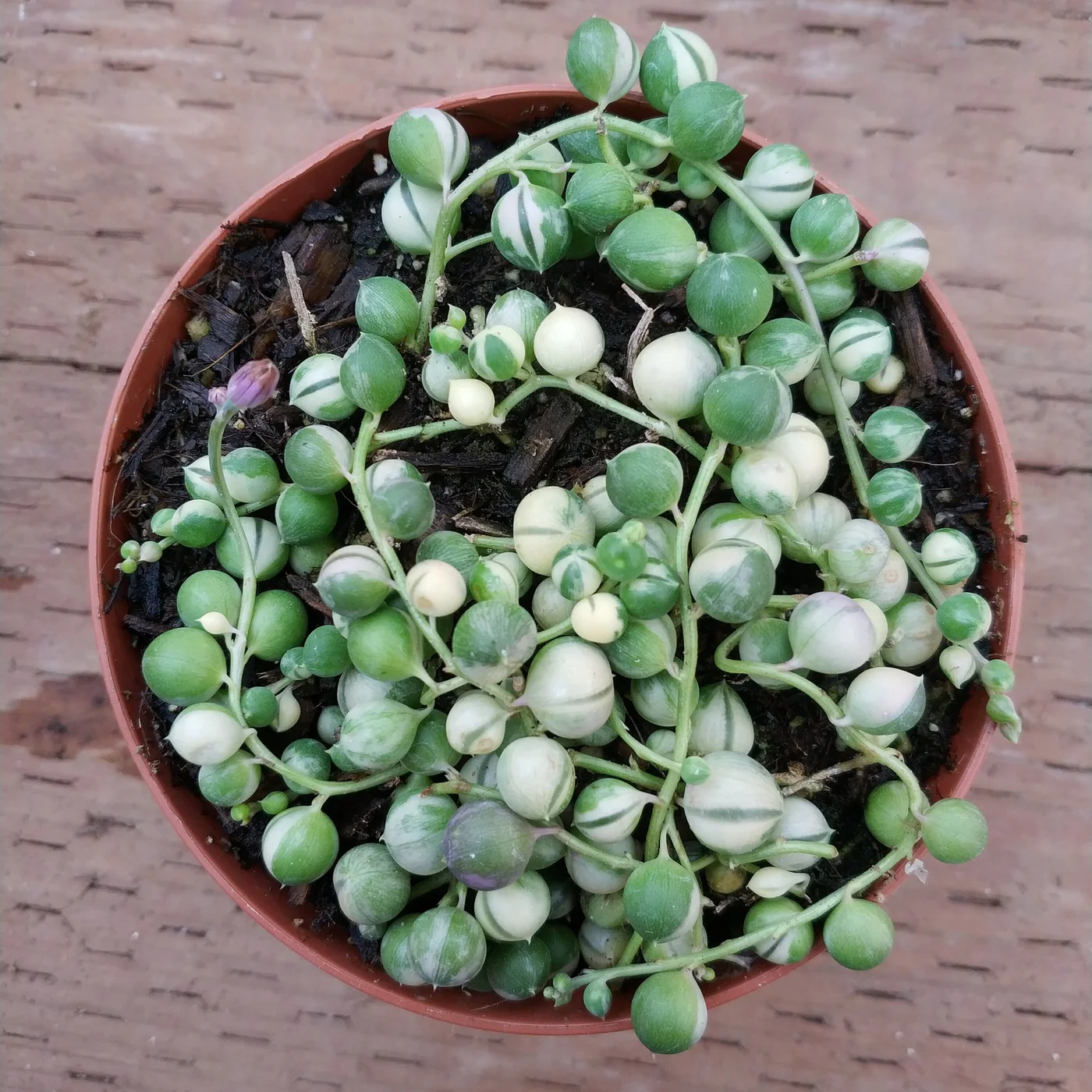
Senecio rowleyanus "Variegated String of Pearls"
In the variegated version of String of Pearls, the pearl-like leaves are swirled in cream, green, and sometimes even pink and purple colors with the right combination of sun and water. For a full, mature look, prune long strands and place back in the pot to re-root. Summer Dormant Partial.
Size: Over 12"
Growth Habit: Hanging / Trailing
Soil: Well-draining succulent soil with 50% to 70% mineral grit such as coarse sand, pumice, or perlite.
Light: Indirect bright light. Due to lack of chlorophyll in the variegated parts of plant, they can sunburn in direct sunlight.
Water: Only water when the soil is dry; a slight wrinkling of the leaves indicates the plant is ready for water.
Hardiness: Zone 10 (30F)
Protect from frost
-
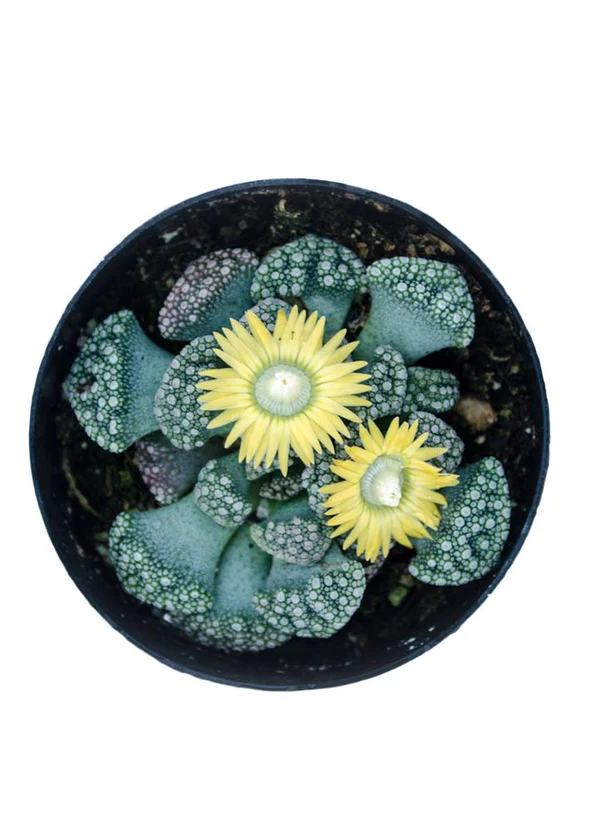
Titanopsis calcareum 'Concrete Leaf'
A mimcry plant, 'Concrete Leaf' is a small, slow-growing, low maintenance plant that is especially happy sitting on your bright windowsill! It grows as a clump of blue-green leaves with bumpy, white dots at the leaf's end. It camouflages so well in its rocky habitats that it is often only found while in bloom.
Size: Under 3"
Growth Habit: Clumping / Mounding, Low Growing / Creeping
Soil: Porous, moderately dry, with 50–70% mineral grit like pumice, perlite, or coarse sand
Light: Bright Indoor Light, Full Sun
Water: Water deeply enough for water to run out the drainage hole, then wait for the soil to fully dry before watering again.
Hardiness: Zone 10 (30F)
Protect from frost

